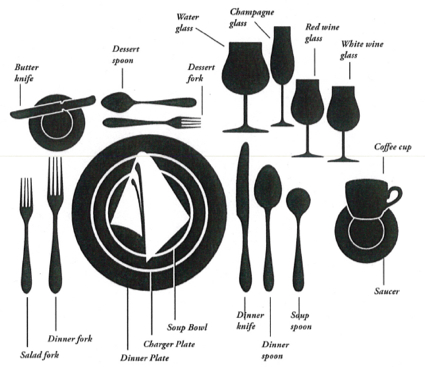Dining Etiquette
- Introductions - Give your 30-second commercial: Your name, major, and career goal. Then extend your hand for a handshake. Proper handshake involves eye contact and a 3-second firm grip (not a limp or bone-breaking one. Ladies, it's OK to extend a hand to men first.
- Introducing others - Introduce younger person to older person; introduce a non-official to an official; introduce junior to senior. Use first names ONLY after you are given permission. Saying "Hello, I'm pleased to meet you" is a standard and sufficient response to an introduction.
- Seating - At a business meal, men and women seat themselves. However, it's wise to ask an older female, whose standards may be of a previous era, if she would like herchair held. It's never wrong to ask any woman, "May I hold your chair?" Nowadays, everyone agress that holding the door for the next guy is still a nice gesture. Sit about 2 flat hands away from your stomach away from the table.
- Napkin - Immediately after sitting, place your napkin in your lap. Large napkins can be folded in half or with a quarter folded over the top. If you excuse yourself from the table, loosely fold the napkin and place it to the left of your plate.
- Rule for silverware - Work from the outside in.
- Wine, coffee, tea - Since white wines are normally chilled, hold a white wine or champagne glass by the stem to prevent heat transfer from the hand. The larger, heavier red wine glass can be held by cupping the bowl, but the modern practice is to hold it by the stem, to prevent the wine from being warmed further. Declining wine: Don't turn wine glasses upside-down to indicate you don't want wine. Simply say, "No thank you" when wine is offered. Same with coffee and tea.
- Direction - Food is served from the left. Dishes are removed from the right. Pass food from the left to right.
- Oops! - If you drop food on the floor, let it stay. If you drop your utensil on the floor, ONLY pick it up if it is of danger to someone else. Otherwise, let it stay and ask for a clean utensil.
- Seasonings - If asked for salt or pepper, pass both together. Tast food first before seasoning it.
- Butter - Butter, spreads, or dips are transferred from the serving dish to your plate before spreading or eating. Remember to tear off bite-size portions of your bread as you eat.
- Soup - Dip spoon into soup, from the edge of the bowl to the center (12 o'clock), moving away from you. Only fill it 3/4 full to avoid spilling. Sip not slurp from the edge of the spoon into your mouth. If soup is too hot, let it cool in the bowl. Do not blow on soup. When finished,leave the soup spoon in the bowl or cup with the handle at about 4 o'clock.
- Practice good posture. If not eating, place your hands in your lap or rest your wrists on the edge of the table. The no-elbow-on-the-table rule applies only when you're actually eating, but not when you're conversing. Whenever your utensils aren't in hand, it's OK to put your elbows on the table and lean forward slightly. It shows you're engaged.
- American and European styles - American (or sigzag) style: After food is cut, place the knife along the upper edge of the plate, then switch the fork to your dominant hand before raising it, tines up, to your mouth. European style: Utensils don't change hands. Once the food is cut, lower your knife hand toward the plate and raise the food to your mouth with your fork, tines down. Whatever method you choose, cut and eat one piece of meat at a time.
- Resting flatware - American style: When you pause to take a sip of your beverage or to speak with someone, place your knife along the upper edge of your plate, and put the fork below, at about the 3 o'clock position. European style: Place your knife and fork on your plate near the center, slightly angled in a "V" and with the tips of the knofe and fork pointing toward each other (tines may be up or down). This signals you are not finished.
- When finished - Lay your knife and fork side by side, diagonally, on your plate. If your plate were a clock face, the handles would lie at 4 o'clock and the blade or tines toward 10 o'clock. The knife blade faces inward but the fork tines can be either up or down, signaling your host or the server that you are finished.
Manners are Important
Do not: smoke, chew gum, talk with your mouth open, remove lipstick with your napkin, or reapply makeup.
Remember that technology impacts those around you. When you use your cell phone, iPhone, BlackBerry, iPod or smart phone, be polite! Use your judgment before reaching for that ringing phone. In fact, think twice about even leaving it on. If it is important to take a call, excuse yourself from the table and take the call in another room, such as a lobby or restroom.
Be an etiquette superstar!

Source: Adapted from Emily Post's Etiquette: Manners for a New World, 18th ed.